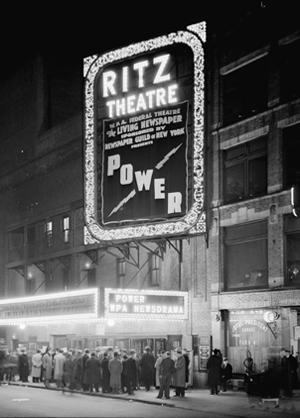
About the Interviews
The bulk of the WPA Oral History Interview Collection was compiled between 1975 and 1983 by staff of the Research Center for the Study of the Federal Theatre Project, later called the Institute for the Study of Government, Society, and the Arts. The majority of the interviews were conducted with former personnel of the Federal Theatre Project, but there were also interviews conducted with individuals who took part in the Federal Art, Music, and Writers’ Projects. The interviews were conducted mostly at the interview subjects’ homes.
All interviews were recorded on magnetic audio tape. The majority of them appear to have been recorded on compact cassette, a simple, inexpensive, convenient, and popular consumer alternative to the open-reel format commonly used until the mid-1970s. A smaller number of interviews were recorded on open reel tape.
The recordings reflect the nature of magnetic tape recording in a remote location (outside of a professional studio and without the assistance of a recording engineer) and the drawbacks inherent in this capture method. Cassette tapes have two tracks or “sides” on which to record, and usually capture 30 to 31.5 minutes of content per side, recording at a fixed speed. Seven-inch open reel tape can record from about 60 to 120 minutes per reel, depending on the selected recording speed. On several of the WPA recordings, a tape or one side of a tape appears to have run out in the middle of an interview during a question or the answer to a question. On some of these recordings, the interview simply continued once tape was resupplied to the recorder without backtracking to the point in the interview where the tape stopped. Situations in which this appeared to have happened have been marked with ellipses (…) in the interview transcript. Recording location and microphone operation and placement are critical in any oral history sound recording. While most of the interviews were conducted in quiet locations with properly operating microphones, some were recorded in challenging settings (public places, and other locations with multiple speakers and/or background noises). The volume on some of the recordings is lower than desirable, possibly due to a malfunctioning microphone or mic placement issues. All attempts have been made to boost the output on low volume tapes and enhance listenability of the interviews during this project.
Typewritten transcripts of the interviews were created by staff members of the Center during the 1970s and 1980s. Transcripts were prepared for about 80% of the interviews in this project by the interviewers or other Research Center for the Study of the Federal Theatre Project staff. The remaining transcripts were created from the audio files using an online transcription service, then reviewed and edited by University Libraries staff during the CLIR project.



